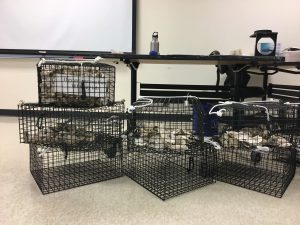“It was a bold man who first ate an oyster,” said writer and satirist Jonathan Swift. Historically in many parts of Florida, oysters were once harvested and consumed, but today those areas are few and far between. The compounding issues of degrading water quality and changes in freshwater inputs has created a decline in oyster reefs at an alarming rate worldwide. To solve this immense problem natural resource managers and scientists have worked together to try and restore these oyster reefs. But to restore these reefs, you first need oysters.
Cue oyster gardening, like growing your own garden but underwater. Participants maintain oyster shells that have tiny oyster spat (baby oysters) inside of a cage that is hung off their dock. Gardeners will check on them weekly, cleaning the shells from fouling organisms and recording a few water quality parameters. After about eight months, the oysters are too large for their cage and will be transplanted to a nearby oyster reef restoration site in the Nassau River.

UF/IFAS Nassau County Extension is planning to begin an Oyster Gardening Program similar to the program in St. Johns County. If you own a dock in a salty waterway with tidal flow and see evidence of oysters growing naturally nearby. Then, you must attend a two-hour workshop to learn more about the oyster gardening requirements and become trained on how to maintain the habitats and record important data.
If interested in becoming an oyster gardener or “oyster buddy,” please contact Justina Dacey at jdacey@ufl.edu
 0
0
